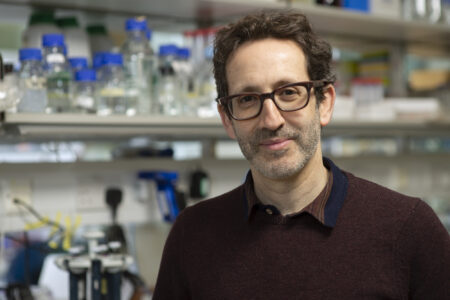Professor Buzz Baum
Professor Buzz Baum is a group leader at the MRC Laboratory of Molecular Biology in Cambridge, where his team studies the cell biology of archaea and the origins of complex cells.
Buzz was named after the second man on the moon, but was always more interested in life than space. He grew up in the UK and studied Biochemistry as an undergraduate at St Catherine’s College, Oxford. In 1993, he joined Sir Paul Nurse’s lab in London as a PhD student, studying the process by one fission yeast cell becomes two. Buzz then undertook a post-doc with Norbert Perrimon at Harvard Medical School, where he explored how animal cells shape themselves and the developing fruit fly ovary.
Upon his return to the UK in 2001, Buzz set up a lab at UCL to study animal cell division, fruit fly morphogenesis, and cancer. Then in 2013, in collaboration with his cousin, the evolutionary biologist David Baum, Buzz embarked on a new research path with the goal of thinking afresh about the origins of eukaryotes – one of the most remarkable and poorly understood events in the history of life on earth. Baum and Baum published the “inside-out” model in 2014. This proved prescient as it pre-empted the discovery of the Asgard archaea, the closest prokaryotic relatives of complex cells in 2015, which when imaged were found to possess long thin protrusions through which they share resources with partners of different species, just as had been envisaged in the model. In 2020 Buzz moved his lab to the MRC-LMB, where his interdisciplinary team is helping to pioneer a new field of archaeal biology, using experiment and theory to reveal mechanisms of cell shape and cell cycle control shared by organisms across the tree of life, with the aim of putting the inside-out model to the test.
Buzz co-organised the world’s first Creative Science Writing workshop in 2023, runs a creative writing workshop for PhD students, and is currently writing a book.
Select publications
- Origins of the nucleus: a hypothesis. Baum B* and Spang A (2023). Microbiology and Molecular Biology Reviews, e00186-21.
- Bacterial Vipp1 and PspA are members of the ancient ESCRT-III membrane-remodelling superfamily. Liu J^, Tassinari M^, Souza DP^, Naskar S^, Noel JK, Bohuszewicz O, Buck M, Williams TA, Baum B*, Low HH*. (2021)
Cell 184 (14) 3660-3673. - Closed mitosis requires local disassembly of the nuclear envelope. Dey G, Culley S, Curran S, Schmidt U, Henriques R, Kukulski W, Baum B. (2020)
Nature 585 (7823):119-123 - The proteasome controls ESCRT-III-mediated cell division in an archaeon. Tarrason Risa G, Hurtig F, Bray S, Hafner AE, Harker-Kirschneck L, Faull P, Davis C, Papatziamou D, Mutavchiev DR, Fan C, Meneguello L, Arashiro Pulschen A, Dey G, Culley S, Kilkenny M, Souza DP, Pellegrini L, de Bruin RAM, Henriques R, Snijders AP, Šarić A, Lindås AC, Robinson NP*, Baum B.* (2020)
Science 369 (6504). - Live Imaging of a Hyperthermophilic Archaeon Reveals Distinct Roles for Two ESCRT-III Homologs in Ensuring a Robust and Symmetric Division. Pulschen AA, Mutavchiev DR, Culley S, Sebastian KN, Roubinet J, Roubinet M, Risa GT, van Wolferen M, Roubinet C, Schmidt U, Dey G, Albers SV, Henriques R, Baum B. (2020)
Current Biology 30, 1–8 - An inside-out origin for eukaryote cells. Baum D, Baum B. (2014).
BMC Biology 12, 76. - Live-cell delamination counterbalances epithelial growth to limit tissue overcrowding. Marinari E, Mehonic A, Curran S, Gale J, Duke T, Baum B. (2012).
Nature 484(7395), 542-545 - Changes in Ect2 Localization Couple Actomyosin-Dependent Cell Shape Changes to Mitotic Progression.
Matthews HK, Delabre U, Rohn JL, Guck J, Kunda P, Baum B. (2012).
Developmental Cell 23(2), 371- 383
Select Awards
- EMBO member
Further links
https://www2.mrc-lmb.cam.ac.uk/groups/baum/buzz-baum/


